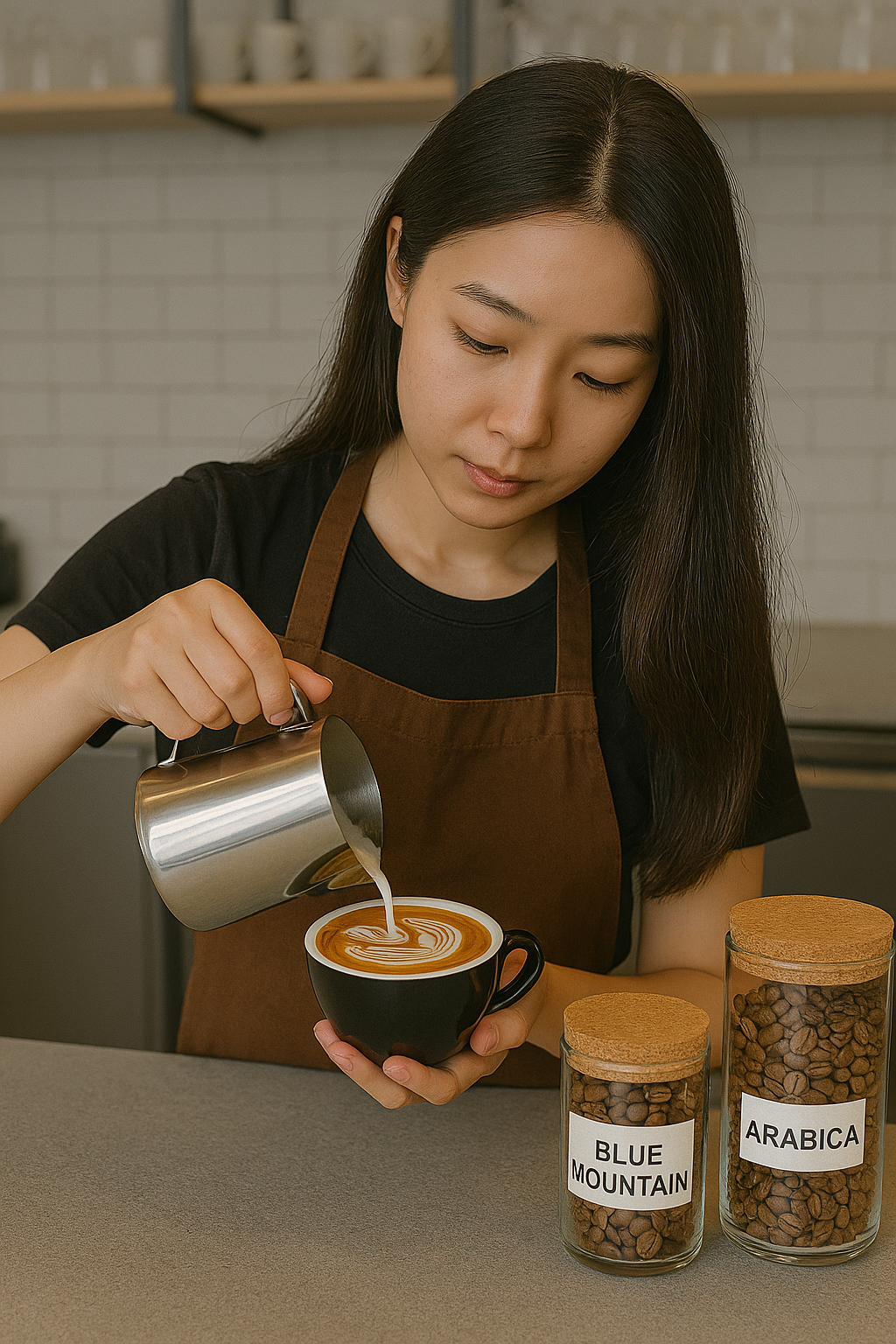Why Espresso Fans Prefer SOE Single Origin Espresso for Clarity
Wiki Article
Coffee Beans Uncovered: Finding the Keys of Coffee and Blended Coffee Beans
When you assume concerning coffee, what comes to mind? Is it the rich scent of espresso or the intricacy of a well-crafted mix? Understanding the subtleties of coffee beans can change your experience. Each selection, from Arabica to Robusta, holds its own tricks. As you check out further, you'll discover how these beans form flavors and effect sustainability. What might you discover concerning your next mug?The Beginnings of Coffee: A Historic Perspective
Although espresso is currently a staple in coffee culture worldwide, its origins trace back to the very early 20th century in Italy. In 1901, Luigi Bezzera patented the first espresso machine, aiming to make coffee faster than traditional methods.Recognizing Espresso Beans: Varieties and Characteristics
When you consider espresso, it's important to identify the various bean selections and their unique flavors. Each kind brings a distinctive personality to your cup, affected by variables like roast levels. Understanding these elements can elevate your espresso experience substantially.Coffee Bean Varieties
As you explore the globe of espresso, you'll promptly discover that not all beans are created equal; each selection brings its very own distinct tastes and qualities to your cup. Arabica beans are recognized for their smooth, nuanced tastes and reduced high levels of caffeine material, making them a favorite among coffee connoisseurs. Each variety offers something various, so exploring will certainly aid you find your ideal coffee.Flavor Profiles Described
Understanding the taste profiles of various espresso beans can raise your coffee experience. Each bean selection offers one-of-a-kind qualities that affect preference, mouthfeel, and fragrance. For example, Arabica beans commonly offer a sweeter, a lot more complex taste with tips of fruit and flower notes, while Robusta beans often tend to be bolder, with nutty and natural undertones.When you discover single-origin beans, you could uncover distinctive local tastes-- Central American beans might be citrusy and intense, whereas Italian blends usually provide abundant, chocolatey notes.
Roast Levels Impact
Roast levels play a crucial function fit the taste and fragrance of coffee beans, influencing your general coffee experience. With light roasts, you'll uncover brilliant level of acidity and extra pronounced fruity notes. As you transfer to tool roasts, you'll take pleasure in a balanced account that showcases sweetness and intricacy. Dark roasts, on the various other hand, often existing rich, bold flavors with a smoky surface, however they can mask the beans' integral attributes. Recognizing these roast levels aids you choose the coffee that fits your preference preferences. Trying out various roasts can cause delightful explorations, enhancing your recognition for coffee. So, don't wait to explore numerous roast degrees and find your excellent cup!The Art of Mixing: What Makes Blended Coffee One-of-a-kind
What makes mixed coffee so interesting? It's all about the art of combining beans from different beginnings, roast levels, and taste profiles. When you blend, you're not just blending; you're producing a harmonious balance that highlights the staminas of each bean. You can experiment with numerous combinations to enhance body, sweetness, and level of acidity, leading to a mixture that's richer and a lot more complex than a single-origin coffee.Mixing also allows you to deal with diverse preference preferences. You can craft a mix that's smooth and mellow or one that's bold and robust, depending upon your audience. And also, mixing can assist preserve consistency, offering a dependable flavor experience despite seasonal variants in beans. So, whether you're a barista or a home maker, grasping the art of blending opens up a globe of creativity and flavor possibilities, making your coffee experience really special - SOE.
Flavor Accounts: Sampling Notes of Espresso vs. Blended Coffee
Mixed coffee supplies a globe of taste opportunities, yet when it involves coffee, you're considering a much more concentrated experience. Coffee generally showcases vibrant, abundant flavors with a thicker mouthfeel. You could see notes of dark delicious chocolate, sugar, or also tips of fruit, depending on the beans. The strength can be both rejuvenating and satisfying.On the various other hand, mixed coffee offers a complex tapestry of flavors. You can explore a variety of tasting notes, from nutty and sweet to floral and fruity. Each mix can offer something one-of-a-kind, often incorporating beans from different regions to develop a balanced profile.
While espresso supplies a punch, mixed coffee invites you to enjoy the subtleties. Whether you like the robust strength of coffee or the complex flavors of blended coffee, each cup tells its very own tale, waiting for you to discover.
Brewing Techniques: Improving Your Coffee Shot
To attain the best espresso shot, Single Origin Espresso understanding the developing techniques is important, as even minor modifications can considerably impact the flavor and high quality. Beginning by utilizing fresh, high-grade coffee beans; grind them just before brewing for optimum taste. Go for a fine work, regarding the uniformity of table salt, to ensure optimal removal.Next, take notice of your water temperature level; it needs to be between 195 ° F to 205 ° F. Too too cool or warm can spoil your shot. Usage concerning 18-20 grams of coffee for a dual shot, and tamp it uniformly with firm stress to produce a consistent puck.
A longer removal can lead to resentment, while also short can result in sour flavors. Exercise these strategies constantly, and you'll fine-tune your skills, attaining that rich, robust coffee shot you hunger for.
The Function of Roast Levels in Coffee and Blended Coffee
After grasping the brewing techniques for espresso, it's time to consider how roast degrees affect the taste profile of your coffee. The roast level can substantially alter your coffee's body, fragrance, and taste. Light roasts have a tendency to highlight the coffee's beginning, providing intense level of acidity and fruity notes, while tool roasts equilibrium level of acidity and sweetness, producing an all-round flavor. Dark roasts, on the various other hand, highlight strong, abundant tastes with reduced level of acidity, usually creating chocolate or great smoky touches.
Checking Out Sustainability: Honest Sourcing of Coffee Beans
When you pick coffee, you're not simply choosing a flavor; you're choosing concerning the effect on farmers and the environment. Understanding Fair Profession practices, organic farming approaches, and certification requirements can aid you sustain sustainable coffee sourcing. Let's check out how these aspects add to an extra honest coffee experience.Fair Profession Practices
Fair Trade practices play a crucial duty in ensuring that coffee beans are sourced ethically and sustainably. You sustain farmers that receive reasonable wages and job in safe conditions when you choose Fair Trade coffee. This dedication to honest sourcing helps combat poverty and advertises area advancement in coffee-growing areas. You'll find that Fair Trade qualification also motivates eco friendly farming methods, as producers are incentivized to safeguard their land and sources. By opting for Fair Profession brand names, you're not simply appreciating an abundant cup of coffee; you're making a positive impact on the lives of those who expand it. Your choice matters, and it links you to a global activity concentrated on justness and sustainability in the coffee sector.Natural Farming Approaches
As you check out the world of ethical coffee sourcing, natural farming approaches become an essential part of sustainability. By selecting organic coffee, you sustain methods that prioritize dirt wellness, biodiversity, and all-natural environments. Farmers avoid artificial chemicals and fertilizers, counting instead on natural garden compost and crop turning to improve soil fertility. This not only secures the setting but also improves the high quality of the coffee you appreciate. Organic farming urges neighborhood wild animals and advertises a well balanced ecosystem, decreasing the opportunities of condition and parasites. Additionally, it frequently brings about more powerful, much healthier coffee plants, leading to richer flavors in your cup. When you choose organic coffee, you're making a mindful option that profits both the earth and your palate.Certification Criteria Explained
Recognizing accreditation criteria is crucial for any person curious about fairly sourced coffee. These requirements, such as Fair Trade, Rainforest Partnership, and USDA Organic, guarantee that coffee is grown under lasting techniques. When you pick certified coffee, you sustain farmers that abide by honest labor practices and environmental management.Fair Trade qualification concentrates on offering fair wages and working problems, while Rainforest Alliance highlights biodiversity and ecosystem conservation. Next time you're at your neighborhood café or grocery shop, look for these labels, and really feel great understanding your coffee purchase favorably impacts communities and the setting.
Frequently Asked Concerns


Exactly How Does Elevation Impact the Development of Coffee Beans?
Elevation influences coffee bean growth by influencing temperature level and climate. Higher altitudes commonly create denser beans with more complex tastes, while reduced elevations can result in faster development but less delicious results. You'll taste the distinction!What's the Difference Between Arabica and Robusta Beans?
Arabica beans are sweeter and much more complicated, while Robusta beans have a stronger, harsher flavor with higher caffeine web content. You'll find Arabica favored for specialized coffees, whereas Robusta's often utilized in immediate coffee and coffee blends.Can Coffee Beans Spoil or Lose Taste Over Time?
Yes, coffee beans can go poor and shed flavor over time. If you keep them incorrectly or keep them too long, they'll end up being stagnant. Always maintain your beans in an impermeable container far from light and dampness.What Are the Wellness Advantages of Drinking Coffee?
Consuming alcohol espresso boosts your power, enhances psychological clearness, and might decrease the risk of specific diseases. It's abundant in anti-oxidants, supports metabolic process, and can boost mood, making it a useful choice for your day-to-day regimen.Just How Does Water High Quality Impact Espresso Removal?
Water top quality significantly impacts coffee removal. It influences the solubility of oils and flavors, affecting taste and scent. Utilizing filtered water can enhance your espresso, making certain a enjoyable and balanced cup each time you brew.Coffee Beans Uncovered: Finding the Tricks of Coffee and Blended Coffee Beans.
Comprehending the flavor accounts of various coffee beans can boost your coffee experience.Roast degrees play a crucial function in forming the taste and scent of espresso beans, influencing your general coffee experience (SOE).Combined coffee offers a globe of flavor possibilities, yet when it comes to espresso, you're looking at an extra focused experience.After grasping the developing techniques for coffee, it's time to ponder how roast levels influence the taste profile of your coffee
Report this wiki page